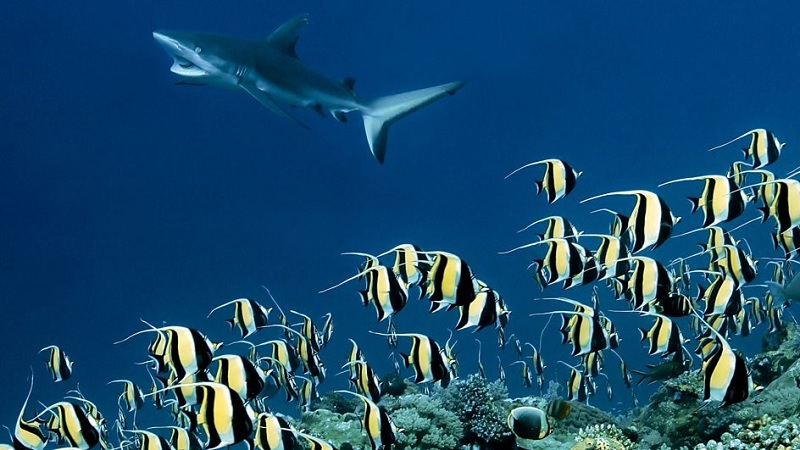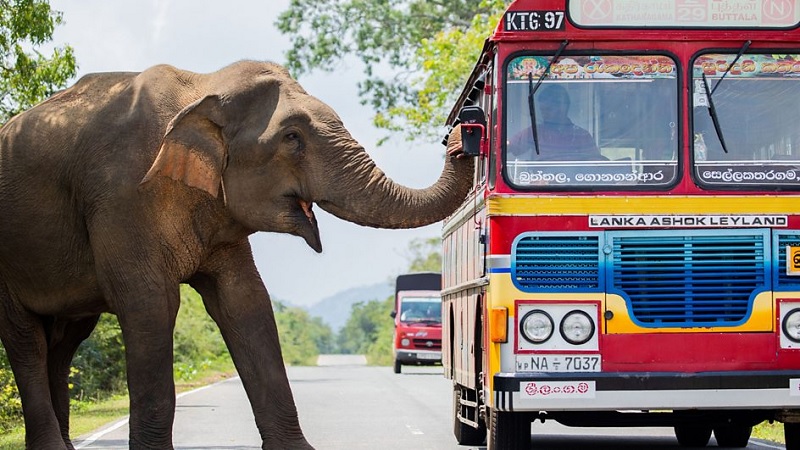Wildlife Filmmaker Roger Webb on making 7-part documentry series ‘Asia’
After filming 2,287 days in 21 countries, executive producer Roger Webb shares insights on making the series, working with Attenborough and uncovering the mystics of Asia.
After filming 2,287 days in 21 countries, executive producer Roger Webb shares insights on making the series, working with Attenborough and uncovering the mystics of Asia.

[Moorish idol (Zanclus cornutus) swimming in a school on the reefs of the Western Pacific, patrolled by a grey reef shark (Carcharhinus amblyrhynchos) (Image: BBC/BBC Studios/Mandy Etpison)]
Recently released, Sir David Attenborough presents Asia, a seven-part series dedicated to our planet’s greatest continent, revealing its most remarkable landscapes and animals.
Filmed over the course of nearly four years, this is the first time that Asia has been the focus of a major BBC wildlife series.
What was the genesis of this series?
The Natural History Unit made the series Seven Worlds, One Planet, five years ago now. The team on that did a tremendous job. And obviously one of the episodes was Asia, which did really well. It became clear that there are so many stories there beyond what was possible to do in a single hour for Seven Worlds, One Planet.

Everybody who was involved in that particular episode just kept talking about it and the riches that were on offer there. Then it came to light that no one’s really done an in-depth series about Asia and its wildlife, taking the continent as a whole. So we started doing more work collating what other stories might be possible and realized we had such a rich list. Also, there’s a certain mystique and romance about Asia.
So many of the places in Asia are on people’s bucket lists to visit. You’ve got that element as well as an incredible cast of animals in incredible places. So we took it to BBC Commissioning, and they were similarly excited about what we proposed. No disrespect to any other continent on the planet, but as Sir David says at the top of the series, there’s nowhere with more untold stories.
For us as wildlife filmmakers, there’s nothing more exciting than that. So that was it. We were just energized and excited. We ran with it, and we’ve had the most amazing four years making the series. The team have done an incredible job.
Why have these stories from Asia been untold for so long, do you think?
When people think of wildlife or wild places, they don’t necessarily jump straight to Asia. But the animals you find in Asia are as big and as charismatic as any you might find in Africa. There are rhinos there, there are elephants, there are, of course, tigers. There are also lions, which I don’t think some people realise. So the riches on offer are on a par with anywhere else in the world.

But for whatever reason, our cameras have not heavily focused on those animals in Asia before. So it’s just such an exciting opportunity for us. Also, technology has moved on so fast in the last five or ten years. To be able to apply that to filming stories that have rarely been told or not told at all is just super exciting for us.
What does Sir David’s involvement add to the project?
David brings so much to anything we do. We were so pleased having him voice Asia. I think he was similarly excited about the stories. It’s always lovely when you get feedback from David and he says, “Oh, I really enjoyed that.” For example, he loved the Moorish idol sequence with the sharks in the Oceans episode “Beneath the Waves.” His enthusiasm never seems to dwindle. If you’re getting a big smile and a thumbs up from Sir David, you’re in a good place!
He’s been an absolute delight to work with. He’s painstakingly gone through every script and fed back to us. He interrogates every word and will review things in great detail. It’s been a great dialogue. Together we’ve been truly able to hone the scripts. He’s 98, and his performance in the commentary is as good as anything I’ve heard before. He still has the same hunger that I believe he had all those years ago. He motivates us as well, which is lovely. To work with him is an honour. He’s an incredible human being, and it’s just so fantastic to be working with him again on this.
Which sequences stand out for you in this series?
The opening sequence in the whole series where a school of Moorish idols are chased by grey reef sharks is quite extraordinary. That has been on quite a few wildlife filmmakers’ bucket lists, but producer Mark [Wheeler] really went for it. He will probably say he got lucky, but he planned everything down to the nth degree, and he worked with a brilliant team. They managed to capture something that’s never been captured before. The fish themselves are beautiful.

They’re little characters with their pursed lips. They remind me of some of the fish in Finding Nemo. They are just instantly charismatic. Then the sharks are also remarkable. The way they pursue the Moorish idols en masse in this frenzy is amazing. The energy and the music and, of course, Sir David’s narration combine with that to create a very powerful and engaging sequence. It is an incredible story, and it really sets us up on the right path for the series.
Which other highlights would you pick out?
The cave swifts in Thailand which feature in the Mountains episode, “Above the Clouds”. That is an amazing spectacle in itself. It’s the greatest concentration of swifts anywhere on the planet. But as they’re nesting in this cave, there’s a little twist to the story. In the water that sits at the bottom of the cave are these big catfish. They are not just minding their own business. They’re looking for a chance to feed. As the swifts duel for a nesting site, they do on occasion fall into the water, and that’s a dangerous place for them to be with these big fish lurking there. Of course, the fish are ready. They’re waiting for these opportunities.
More interviews at Music Press Asia

If there are any ripples in the water, they literally pounce upon them. The poor swifts are basically helpless in the water, doing their best to flap their wings and try to get out. But within moments, they’re dragged beneath the surface and disappear from view. Not only is that incredible behaviour – and to be able to document for the first time is amazing – but it’s also a very powerful story. And yes, of course, we feel for the swifts who are taken, but millions do make it through. And ultimately, theirs is a success story. It’s a great sequence, really well filmed by the team led by the producer Sara [Douglas].
What other outstanding sequences should viewers look out for?
For “The Frozen North” episode, we set out to film the chiru, an antelope that you find on the Tibetan plateau. We went there during the rutting season. They themselves are spectacular animals, and they live in this incredible, barren place over 4,000 meters. It’s a very tough place to live. We embarked on a mission to document the rutting of the chiru, and our cameraman Jacky Poon wasn’t having the best of luck. Then one day he came across this lone wolf. In itself, it was amazing to see this wolf, but then Jacky realized it was quite happy for him to follow it around. So Jacky stuck with this lone wolf, and lo and behold, it started hunting the chiru.

Jacky managed to film the most incredible hunt sequence with this wolf running and running and running, hour after hour, wearing the chiru down. The chiru are actually faster than the wolf, but the wolf has more stamina, and eventually this lone wolf manages to pick off one of the chiru. It’s almost like a test of the fitness of the chiru, and sure enough, as one tires, the wolf is able to take it down. Jacky shot that using drones. The light was fading. The battery was fading. It had all the classic cliches of filmmaking.
Everything was reaching that moment where the team was thinking, “Are we going to get this or not?” But they did get it, and it is a very special and powerful sequence. Full credit to Jacky and the team who worked so hard in a very tough place, where just sleeping and getting around is really difficult due to the altitude and the extremely cold conditions. But all their effort paid off. They have filmed an incredible sequence.
What do you hope audiences will take away from this wonderful series?
A new appreciation of Asia. I hope they will see it through a slightly different lens. The wildlife in Asia is on a par, if not even more incredible than anywhere else in the world. It’s colourful, it’s diverse. The range of habitats is really remarkable. From the frozen north to the baking hot desert, the variety within this single continent is incredible.
“It is a world within a continent. It’s got everything that the planet has. It’s got the highest mountains, the deepest ocean, the tallest rainforest trees. It’s an incredible place with a great cast of characters and animals. It truly is an amazing continent with so many riches. It has a feeling all of its own. It’s very different to anywhere else. Really, it has a kind of magic about it. I believe that comes through in what we’ve produced. It’s genuinely a special place.”
These landmark series are popular all over the world, aren’t they?
Absolutely, they’re sold across the world. I flew to the Middle East last week, and our last series Mammals was available on the plane. That was lovely. It’s very gratifying to see how popular these series are all over the world. I almost wanted to nudge the person sitting next to me on the plane and say, “Would you like to watch that?”
Cover image: Moorish idol (Zanclus cornutus) swimming in a school on the reefs of the Western Pacific, patrolled by a grey reef shark (Carcharhinus amblyrhynchos) (Image: BBC/BBC Studios/Mandy Etpison)
This interview is originally published on BBC’s media centre. Click here to read more about the documentary series.











